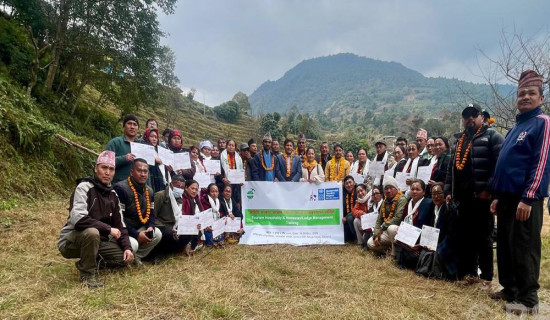- Sunday, 21 December 2025
Tourism In Need Of Congenial Policy
Even amidst policy instability and taxation ‘panic’, Nepal has seen a steady recovery in tourism activities in the post-pandemic scenario with the number of international travellers visiting the country rising significantly. The statistics, released by the Nepal Tourism Board (NTB) few weeks ago, show that the as many as 534,207 tourists entered the country by air alone in the first seven months this year as compared to 285,363 in the same period last year. These figures indicate an encouraging trend in the tourism industry. The country is likely to host almost the same number of visitors in the remaining five months. Though June, July and August are considered as off-season in the nation for the tourism industry, the country hosted a total of 57,725 tourists in July alone. This is a strong indication that this sensitive sector is reviving gradually following the receding of COVID-19.
Having cultural diversity, and topographical and climatic variations, the country is an enticing destination among tourists with varied tastes and interests. Autumn is a favourable tourist season welcoming hundreds of thousands of nature lovers, adventurers and those keenly interested in the people’s culture and lifestyles. No doubt, tourism is the second largest source of foreign exchange for Nepal after the remittance sector. This is the reason why the foreign exchange reserve has received a boost together with the revival of tourism in the country.
Unprecedented fall
But with the outbreak of that lethal viral disease, the tourism industry in the country had suffered a huge setback in 2020 and 2021 when only 230,085 and 150,962 international travellers, respectively, had been recorded. The main reasons for such an unprecedented fall in the number of tourists included protracted lockdowns and other restrictions imposed by most countries around the world to contain the transmission of the fast-spreading disease. Millions of tourism-related jobs were lost to the pandemic globally because tourism activities came to a grinding. In Nepal too, tens of thousands of people involved in tourism and allied sectors became jobless.
However, the situation has started improving gradually since the onset of 2022, thanks to massive vaccination campaigns against the contagion globally. In terms of the number of tourists, India has been the largest tourist source market for Nepal. As the two nations share an open border and their nationals do not require a visa to cross the frontier, it has been easier for them to travel. Another positive side is that Kathmandu is connected by air with several Indian cities like New Delhi, Mumbai and Bangalore. In July, altogether 21,357 Indian tourists came to the country. With numerous hill destinations, Nepal is a preferred destination for many Indians to evade the sweltering heat during summer.
As soon as China included Nepal as the target tourist destination for Chinese citizens in March following the COVID-19 pandemic, more and more tourists from the northern neighbour have been coming here. Last month, the number of Chinese arrivals stood at 5,593 while 5,561 travellers from the United States came to Nepal. As all the six Chinese airlines have resumed their regular flights from different cities to Kathmandu, Nepal may witness a considerable increase in the number of tourists coming from China in the days to come. Bangladesh has also emerged as another important tourist source market for Nepal. In the first seven months this year, more than 13,600 Bangladeshis made their trips to this Himalayan nation. A total of 2,694 Bangladeshi travellers came to Nepal last month. In 2022, more than 25,380 Bangladeshis were in Nepal. In recent days, some700 Bangladeshi travellers arrived in Kathmandu on chartered flights.
The federal government has announced 2023-2033 as the ‘Visit Nepal Decade’ and 2025 as a ‘special year for tourism’ in view of the tourism sector’s vital contribution for the country’s economic development. But one of the incongruities is that the government has imposed a 13 per cent value added tax (VAT) on trekking, tour packages and air tickets. On top of that, the government has also enforced a two per cent luxury tax on the service of five-star and luxury hotels and a five per cent tax for Nepalis going abroad for a visit.
Impact
The travel trade people have intensely opposed the government’s new taxation policy, saying it has caused a sort of panic to the industry. Such taxes are sure to make airfare, tour packages and accommodations very expensive at a time when potential travellers in various countries across the world have been going through difficulties due to recession. Domestic and international airfares have already become much costlier. Airlines have increased airfares, citing various factors, including a fuel price hike. Because of this, Nepal is often dubbed as an ‘expensive’ destination even when the local tourism stakeholders are failing to have the desired benefit. Considering the negative impact of such taxes on the tourism industry, the government needs to review them and come up with a more practicable taxation policy.
The government also needs to intensify consultations with the tourism industry in order to make necessary preparations for the ‘Visit Nepal Decade’ and ‘special year for tourism’. Without concrete planning and strong political commitment, these events might become ineffective. Besides, it is equally essential to make tourism-related policies and laws supportive for this sensitive industry to thrive. Without policy stability and its effective implementation, no plan can materialise. Operationalising the Gautam Buddha International Airport and Pokhara International Airport in full swing is also necessary to boost the tourism sector. But no strong initiative seems have been taken in this connection.
(The author is a deputy executive editor of this daily.)











-(1)-original-thumb.jpg)




